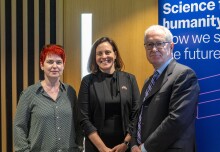

Research reveals that recently introduced vaccine could eradicate polio in Nigeria if it reaches enough children <em>- News Release</em>
Under strict embargo for
22.00 British Summer Time
16 October 2008
A recently introduced polio vaccine is four times more effective at protecting children than previous vaccines and has the potential to eradicate type 1 polio in Nigeria if it reaches enough children, according to a study published today in the New England Journal of Medicine.
See also...
Related news stories:
Nigeria is one of only four countries in the world where polio has yet to be eliminated and 82% of global cases so far this year have been in Nigeria. Polio is highly infectious and it primarily affects children under five years of age. A small minority of infected people develop permanent paralysis, which can be fatal.
The monovalent oral poliovirus vaccine, known as mOPV1, has been used in Nigeria since February 2006 and the number of reported cases of polio in the country fell by 75% between 2006 and 2007.
With each dose of mOPV1 received, a child in Nigeria has a 67% chance of being protected against type 1 paralytic poliomyelitis, according to the new study, which was carried out by researchers from the MRC Centre for Outbreak Analysis and Modelling at Imperial College London, working with international colleagues. The standard trivalent vaccine in the same setting had an efficacy of 16%.
Although the monovalent vaccine is proving very effective, many more children need to be immunised against polio if the virus is to be eliminated in Nigeria, say the researchers. In the North West zone of the country, where the majority of new cases are found, 21% of children report never having received a single dose of the vaccine and a further 55% have received fewer than the recommended four doses.
The new research comes just 4 months after the World Health Assembly expressed alarm over a dramatic increase in type 1 cases in Nigeria because of poor immunisation in the north of the country. The Government of Nigeria subsequently established a Presidential Task Force to identify barriers to immunisation and potential solutions.
Polio primarily affects children under five years of age
A previous study, published in the Lancet in 2007, looked at how well polio vaccines were working in Northern India and revealed that there, although mOPV1 was three times more effective than the trivalent vaccine, environmental factors compromised the efficacy of both the trivalent and monovalent oral vaccines. The researchers behind today's study say that the mOPV1's effectiveness is not as badly compromised by environmental conditions in Nigeria. This means that the key to eliminating polio in Nigeria is reaching sufficient numbers of children with the vaccine, demonstrating the feasibility of elimination in Africa.
Helen Jenkins, the corresponding author of the study from the MRC Centre for Outbreak Analysis and Modelling and the Department for Infectious Disease Epidemiology at Imperial College London, said: "Nigeria and India are responsible for the vast majority of new global polio cases. In Nigeria, we now have an effective vaccine to use and we've seen the start of improvements in vaccine uptake. These last pockets of unvaccinated children now need to be reached to achieve elimination in Nigeria and this in turn will have a dramatic impact on the prospects of worldwide eradication."
The researchers reached their conclusions after analysing the vaccination histories of 21,815 children with acute flaccid paralysis, 14% of whom had polio, collected between January 2001 and December 2007.
This study was supported by the Medical Research Council and the Royal Society.
-ends-
For further information please contact:
Laura Gallagher
Senior Press Officer
Imperial College London
e-mail: L.Gallagher@imperial.ac.uk
Telephone: +44 (0)20 7594 6702 or ext. 46702
Out of hours Duty Press Officer: +44 (0)7803 886 248
Notes to editors:
1. The Global Polio Eradication Initiative is spearheaded by the World Health Organisation, Rotary International, the US Centers for Disease Control and Prevention and UNICEF. The effort, launched in 1988, has seen endemic polio transmission stopped everywhere except in parts of India, Pakistan, Afghanistan and Nigeria. Vaccination is a key part of this initiative. When the initiative began it was estimated that polio was paralysing 1,000 children every day, whereas in 2007 this number was estimated at approximately four children a day.
2. mOPV1 targets type 1 polio, the most prevalent of the three strains of the disease, compared with the trivalent vaccine, which targets types 1, 2 and 3. Trivalent vaccines can have limited effectiveness because different strains of poliovirus interfere with one another inside the body, producing immunity to one strain but not another. Monovalent vaccines do not incur problems with interference between vaccine strains because they include just one of the three strains.
3. "The effectiveness of immunization against polio in Nigeria,"New England Journal of Medicine, 16 October 2008 Helen E Jenkins(1)*, R Bruce Aylward(2), Alex Gasasira(3), Christl A Donnelly(1), Emmanuel A Abanida(4), Titi Koleosho-Adelekan(4), Nicholas C Grassly(1)
*Corresponding author
(1) MRC Centre for Outbreak Analysis and Modelling, Department of Infectious Disease Epidemiology, Faculty of Medicine, Imperial College London, London, UK
(2)Global Polio Eradication Initiative, WHO, Geneva, Switzerland (3)WHO-Nigeria, UN House P.M.B. 2861, Abuja, Nigeria (4)National Primary Health Care Development Agency Plot 681/682, Port Harcourt Crescent, off Gimbiya St, Area 11, Garki, Abuja, Nigeria
4. About Imperial College London
Consistently rated amongst the world's best universities, Imperial College London is a science-based institution with a reputation for excellence in teaching and research that attracts 12,000 students and 6,000 staff of the highest international quality. Innovative research at the College explores the interface between science, medicine, engineering and business, delivering practical solutions that improve quality of life and the environment - underpinned by a dynamic enterprise culture.
Since its foundation in 1907, Imperial's contributions to society have included the discovery of penicillin, the development of holography and the foundations of fibre optics. This commitment to the application of research for the benefit of all continues today, with current focuses including interdisciplinary collaborations to improve health in the UK and globally, tackle climate change and develop clean and sustainable sources of energy. Website: www.imperial.ac.uk
5. 60; The Medical Research Council supports the best scientific research to improve human health. Its work ranges from molecular level science to public health medicine and has led to pioneering discoveries in our understanding of the human body and the diseases which affect us all. www.mrc.ac.uk
6. The MRC Centre for Outbreak Analysis and Modelling was founded in March 2007 with Professor Neil Ferguson as Director. Its mission is to be an international resource and centre of excellence for research on the epidemiological analysis and modelling of novel infectious disease outbreaks. Based at Imperial College London, the centre also involves staff at the UK Health Protection Agency. Centre researchers are world leaders in epidemic modelling and have extensive experience of advising governments and international agencies on the control of a wide range of diseases, including influenza, SARS, polio, HIV, BSE and foot-and-mouth disease. The centre builds on this experience and provides the infrastructure to establish long-term relationships with public health bodies around the world.
Article text (excluding photos or graphics) available under an Attribution-NonCommercial-ShareAlike Creative Commons license.
Photos and graphics subject to third party copyright used with permission or © Imperial College London.





